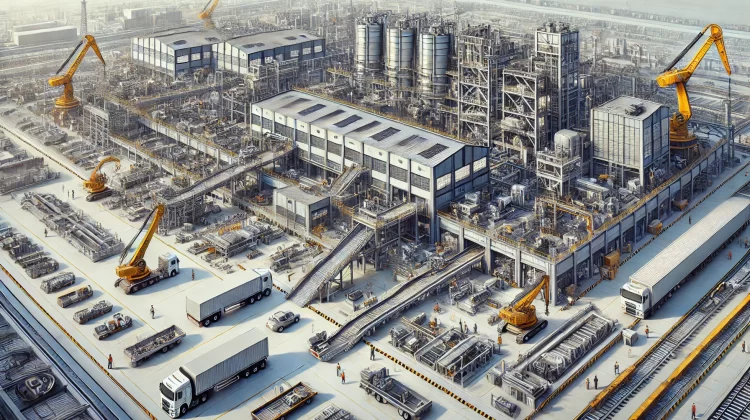
- Client :
- Category :Discrete Events
- Project Url :
- Date :February 4, 2025
The Challenge
This project involved a production facility where certain products are produced. The facility was still in the planning phase and was still under construction. The project focused on developing a digital twin to analyze production, logistics, and warehouse operations over a long-term planning horizon. The goal was to evaluate machine commissioning schedules, material flow, and production throughput while ensuring efficient intra-logistics and resource utilization.
A key challenge was determining the optimal timing for machinery deployment, whether earlier, later, or as originally planned—to balance capacity, demand, and operational efficiency. Additionally, understanding how storage, transport, and production processes interact over time was essential for strategic decision-making.
Raw materials arrive at the facility and are stored in storage areas. Sales are estimated with around a 20 years lookahead and are distributed over the months of a year according to seasonality ratios. There are several production lines or machines in the facility, however, each machine is set to be commissioned at a certain date. Each machine is used for a specific type of product. Production starts based on the estimated sales values. Production is always done in lot sizes, which means that the number of products to be produced is always rounded to a lot size. Raw materials are moved from storage to the production line in different types of containers that have different capacities using specific transportation vehicles for each container type. In fact, one of the objectives was to check the most efficient container type to be used. The transportation vehicles are also responsible for certain transporting materials between production steps and finally transporting the final products to a storage location before they are picked up from the warehouse for distribution.
The Solution
A simulation model was developed using AnyLogic’s Process Modeling Library to replicate the complete production process. A 2D layout was created in the model that represented the true facility layout with the proposed storage and production lines locations.
All the information relevant to all the production and materials details was configurable from an excel sheet. The input database for the model was quite big and included details such as:
- estimated sales per year for each product type with seasonality ratios per month
- production lot sizes for each product type
- each type of containers capacity for each product type
- machines planned commissioning dates and percent utilization to account for breakdowns
- raw materials composition for each product type
- process production steps for each product type with relevant cycle times at each step
- setup times of machines between different production types
- transportation vehicles details such as their count, movement speed, and loading/unloading durations
All this information can be defined and values modified by the user to test different scenarios and alternatives. Moreover, to allow for greater flexibility in the processes, the steps were read from the excel sheet and converted into a recipe in the model relevant to each product type.
Raw data was exported from the model that allowed the client to conduct all sorts of analysis using their software of choice (using python for example). This data included:
- information related to vehicles movement such as initial location, destination, time of start and arrival, number of transported materials, etc.
- information related to product processing steps such as the name of the step and the start and end time
- information related to storage such as storage location and the time of arrival and departure from storage
- information related to production orders such as the order id and waiting times for available production lines or machines
Results
By leveraging digital twin technology, the company gained a powerful tool for long-term strategic planning, allowing for proactive decision-making in production and logistics. Specifically, the client used the model for production scheduling by simulating the impact of different machine commissioning dates on output and efficiency, and material flow analysis by tracking inbound deliveries, storage requirements, and movement between processing stages.

